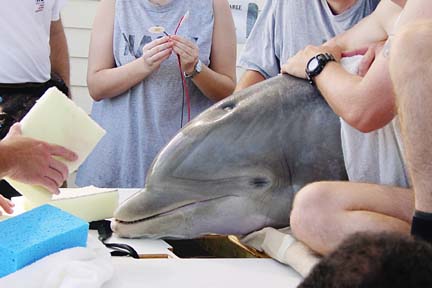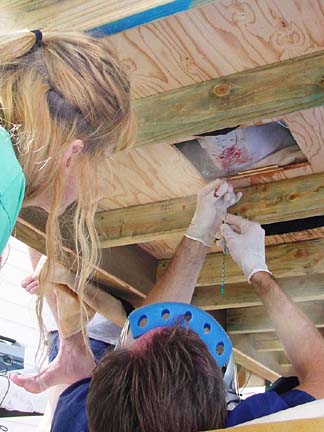
COURTESY PHOTOS BY TIM RUBIN
A photo of Akeakamai during her surgery.
Dolphin’s tumor
therapy makes
medical historyA complex procedure
uses radiation to fight
the animal's cancer
Radiation oncologist John Lederer and a team of doctors and supporters have made medical history with bottlenose dolphin Akeakamai at the Kewalo Basin Marine Mammal Laboratory.
Lederer treated a cancerous tumor on the floor of the dolphin's mouth with brachytherapy, a technique he introduced to Hawaii in 1998 for prostate patients. It involves implanting radioactive seeds directly into a tumor site, which had never been done on an animal.
The 27-year-old dolphin was swimming and eating fish in her pool minutes after the hour-long procedure Aug. 16, said Lederer, medical director of the Nae'a Radiation Oncology Department at the Queen's Medical Center.
"It was totally amazing," he said, describing incredibly complicated logistics, planning and preparation by many people.
The unique operation presented multiple problems, from obtaining special licensing to many hours on the computer to map tumor sites, determine radiation doses and sequencing of seeds, he said.
Lederer performed the procedure lying on his back on an auto mechanic's cart, sliding in and out under a table that held the 420-pound patient.
Jeff Pawloski, University of Hawaii laboratory animal services manager, had a wide table built especially to hold the dolphin and eight people who supported and comforted her, said Dr. Carolyn McKinnie, Kewalo lab veterinarian.
Pawloski designed the table with an opening so the dolphin could rest comfortably on her stomach with her tumor area exposed to Lederer below, McKinnie said. "He was working sort of upside down."
The staff observed the dolphin around the clock for two days, and she is still being monitored closely, McKinnie said.
"She's doing fantastic," the veterinarian said. "The first day, she was a little sedated, and we tried to keep her mellow. Now she's whistling, calling out to people" and starting to do jumps on her own.
Louis Herman, the UH psychologist who founded and heads the Kewalo research facility, said Akeakamai has "always been a groundbreaker," from learning sign language to communicating via TV to the medical first. "She's one special dolphin."
He said the procedure would have been impossible without the doctors and specialists and many others who contributed time, expertise and supplies.
"We're talking thousands and thousands of dollars it would cost if we had to purchase services from Dr. Lederer to CAT scan rooms and technicians and time put in, and all of this was done for the love and care of this dolphin."
McKinnie said UH donated money for the crane to lift the dolphin out of her pool; Emergency Medical Services loaned the facility oxygen tanks and an EKG machine; and ONCURA, a New York company that offers cancer treatment options, donated radioactive seeds worth about $7,000.
Sandra Labat, prostate cancer specialist, delivered the seeds from the mainland and "was so enthralled by the procedure" that she bought lunch for about 30 people at the lab, Herman said.
COURTESY PHOTOS BY TIM RUBIN
Radiation oncologist Dr. John Lederer, right, treated a tumor on the floor of the dolphin's mouth by lying on his back on an auto mechanic's cart and sliding in and out under a table that held the animal. Looking on at left was Kewalo lab veterinarian Dr. Carolyn McKinnie.
Volunteers and staff at the lab hoisted the dolphin from her pool, monitored her respiration and time out of the water and kept her skin moist.
Army volunteers recruited by Pawloski "literally used their bodies to drape over her so she felt restrained," Herman said, pointing out dolphins cannot be placed under general anesthesia.
Lederer said the dolphin was taken out of the pool at 7:45 a.m., and he started putting needles in at 9 a.m.
He said Akeakamai jerked a few times but did pretty well with topical anesthetics and sedation under the chin area.
The tumor was slow-growing but fairly sizable at about 5.5 inches and could not be eliminated, he said, so his goal was to shrink it and reduce pain and bleeding so the dolphin would feel better.
Secondly, he wanted to show the procedure technically could be done safely so decisions can be made sooner in similar cases in the future, he said.
He said peak effects of the radiation will show up over the next few months. If the dolphin looks good, is eating and requiring less pain medication, he said, "Then I'm going to say not only is it technically a success, but the patient is better off."
Lederer said he heard of the dolphin's tumor 2 1/2 to three years ago, but "people were understandably concerned about doing something this radical, never done before."
McKinnie said she and Lederer began talking about brachytherapy about two years ago, but it was difficult to arrange.
She said she had done four laser surgeries on Akeakamai and was the first to use chemotherapy on a dolphin, injecting the agent directly into the tumor in 17 treatments.
They reduced the tumor and caused partial remission, but it began growing back in the past two years and the dolphin has been on a lot of pain medications, she said.
Through intricate arrangements by Queen's and the Kewalo lab, the dolphin was taken to the hospital July 20 for a CAT scan.
The radiation specialists developed a three-dimensional coordinate system based on the scan to cover as much of the tumor as possible with a certain radiation dose, Lederer said.
They used a template to show them where and how deep to drop the seeds, from the deepest part of the dolphin's mouth to the closest part of the skin surface, he said.
McKinnie helped to design a bite plate for the dolphin and figure out where three titanium markers were implanted after the CAT scan to map the tumor site.
A grid was attached to the dolphin's skin over the markers with pre-measured depths at all the positions where he wanted to insert needles with radioactive seeds, Lederer said.
Instead of dropping 175 loose seeds, he said he dropped them in what are called RAPID strands, which could be done more quickly in case she moved. He had 28 needles but did not use three. Needles were stored according to the pattern on the grid and handed to him when he called out the numbers.
"The coolest thing we did," Lederer said, was to devise a way to get the needles in the right places if the dolphin moved.
He said he and Ron FitzGerald conceived the idea of simply cutting the plastic sheath around the needle at the point where they wanted it to stop after insertion. "Little details made a huge difference."
Lederer's group had to apply for a licensing exemption from the Nuclear Regulatory Commission to work on the dolphin, and Herman had to get special permits from the Office of Protective Resources and U.S. Department of Agriculture.
Lederer had splash guards over his eyes and face because of water and blood dripping down on him. Still, he said, "It was fun, really a great experience, like field-conditions kind of surgery."
Considering uncertainties involved, he said the plan worked and he would not have done anything differently. "To me it was as successful as I could have hoped it would be."
He was able to go into the pool afterward with McKinnie to play with their groggy patient, he said. "She's real people-oriented, an amazing creature," he said. He visits her when he has a chance and calls McKinnie every day to check on her, he said.
Herman said: "You wouldn't know she had any surgery. She's a strong animal, and the first thing she wanted to do when we finished the process and she went back in the water was eat. She will eat everything you give her and pretend she didn't eat anything."

